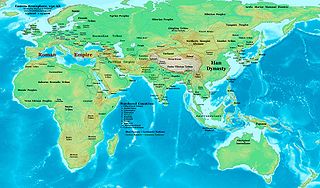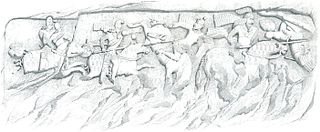AD 68 (LXVIII) was a leap year starting on Friday of the Julian calendar. At the time, it was known as the Year of the Consulship of Silius Italicus and Trachalus, or the start of the Year of the Four Emperors. The denomination AD 68 for this year has been used since the early medieval period, when the Anno Domini calendar era became the prevalent method in Europe for naming years. These are now used throughout the world.
AD 41 (XLI) was a common year starting on Sunday of the Julian calendar. At the time, it was known as the Year of the Consulship of C. Caesar Augustus Germanicus and Cn. Sentius Saturninus. The denomination AD 41 for this year has been used since the early medieval period, when the Anno Domini calendar era became the prevalent method in Europe for naming years.
AD 54 (LIV) was a common year starting on Tuesday of the Julian calendar. At the time, it was known as the Year of the Consulship of Lentulus and Marcellus. The denomination AD 54 for this year has been used since the early medieval period, when the Anno Domini calendar era became the prevalent method in Europe for naming years.

The 20s decade ran from January 1, AD 20, to December 31, AD 29.

The 40s decade ran from January 1, AD 40, to December 31, AD 49.

The 50s decade ran from January 1, 50, to December 31, 59. It was the sixth decade in the Anno Domini/Common Era, if the nine-year period from 1 AD to 9 AD is considered as a "decade".
AD 44 (XLIV) was a leap year starting on Wednesday of the Julian calendar. At the time, it was known as the Year of the Consulship of Crispus and Taurus. The denomination AD 44 for this year has been used since the early medieval period, when the Anno Domini calendar era became the prevalent method in Europe for naming years.
AD 47 (XLVII) was a common year starting on Sunday of the Julian calendar. At the time, it was known as the Year of the Consulship of Claudius and Vitellius. The denomination AD 47 for this year has been used since the early medieval period, when the Anno Domini calendar era became the prevalent method in Europe for naming years.
The 0s BC is the period between 9 BC and 1 BC, the last nine years of the before Christ era. It is one of two "0-to-9" decade-like timespans that contain nine years, along with the 0s.
AD 53 (LIII) was a common year starting on Monday of the Julian calendar. At the time, it was known as the Year of the Consulship of Silanus and Antonius. The denomination AD 53 for this year has been used since the early medieval period, when the Anno Domini calendar era became the prevalent method in Europe for naming years.
The 160s decade ran from January 1, 160, to December 31, 169.
The 170s decade ran from January 1, 170, to December 31, 179.
Year 165 (CLXV) was a common year starting on Monday of the Julian calendar. At the time, it was known as the Year of the Consulship of Orfitus and Pudens. The denomination 165 for this year has been used since the early medieval period, when the Anno Domini calendar era became the prevalent method in Europe for naming years.
The 240s decade ran from January 1, 240, to December 31, 249.
This article concerns the period 19 BC – 10 BC.
Year 248 (CCXLVIII) was a leap year starting on Saturday of the Julian calendar. At the time, it was known as the Year of the Consulship of Philippus and Severus. The denomination 248 for this year has been used since the early medieval period, when the Anno Domini calendar era became the prevalent method in Europe for naming years.
Year 270 (CCLXX) was a common year starting on Saturday of the Julian calendar. At the time, it was known as the Year of the Consulship of Antiochianus and Orfitus. The denomination 270 for this year has been used since the early medieval period, when the Anno Domini calendar era became the prevalent method in Europe for naming years.
Year 197 (CXCVII) was a common year starting on Saturday of the Julian calendar. At the time, it was known as the Year of the Consulship of Magius and Rufinus. The denomination 197 for this year has been used since the early medieval period, when the Anno Domini calendar era became the prevalent method in Europe for naming years.
Year 346 (CCCXLVI) was a common year starting on Wednesday of the Julian calendar. In the Roman Empire, it was known as the Year of the Consulship of Constantius and Claudius. The denomination 346 for this year has been used since the early medieval period, when the Anno Domini calendar era became the prevalent method in Europe for naming years.

Year 224 (CCXXIV) was a leap year starting on Thursday of the Julian calendar. At the time, it was known as the Year of the Consulship of Iulianus and Crispinus. The denomination 224 for this year has been used since the early medieval period, when the Anno Domini calendar era became the prevalent method in Europe for naming years.



